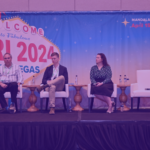
What is the gap between brands and recyclers that needs to be bridged? The session started off with the panelists getting to the meat of the issue. The panel included Amy Uong, senior recycling manager at Nestle Nespresso USA, Jason Pelz, VP of sustainability-US, Canada, Central America and the Caribbean at Tetra Pak, Inc, Dan Liswood, senior project director at the Center for the Circular Economy, Shannon Gay, director of recycling and environmental policy at WM, and Scott Byrne, director of Global Sustainability Services at Sonoco Paper.
Pelz believes that the gap still exists because of a lack of information between both sides. Also, there has been a desire to bridge the gap, but it is not easy to bring desire and will together. In order to truly bridge the gap, work must be done with the end market to understand what the value proposition truly is. Getting people to think down the road and look beyond the normal of what’s recycled. Byrne echoed a similar sentiment but also included education on both sides as a key source to closing the gap.
Gay warned that when operating in bubbles, there is a tendency for finger pointing (“…not my fault this isn’t recyclable or your MRF can’t recycle this…”). Collaboration is needed to work on tougher issues and close the gap. Uong agreed that collaboration is key but added a bit more nuance since packaging is designed to serve the product and that can make designing for recycling trickier. She gave an example of certain material and grades being used because they help keep food fresh and prevent spoilage though the materials might be harder to recycle.
Liswood focused on recycling as a business that needs to be efficient. Seeing ways of how brands can see these challenges would also help bridge the gap.
Pelz also proposed an outside the box solution: sit at a table with your competitors. “Helping find solutions for a MRF to be able to sort or other solutions takes a lot of minds to make it happen,” said Pelz. Gay agreed, “different trade associations come in to help and have a facilitator for some of these conversations. Working with coalitions that focus on specific material type is helpful to test some of this stuff out; helps with trial and error.”
The panel also went into the legislative side, including the role policy plays. The panel explained that there is no one single position as different states have different legislative language. For example, extended producer responsibility (ERP) bills in Colorado have the state provide funding for recycling in the state. Oregon leverages the resources of producers to cover the cost of improvements. Policy also adds a timeline to finding solutions as seen in California where by 2032 100% of packaging in the state has to be recyclable or compostable. “EPR is going to bring more people to the table, more interested parties. Solutions that come will come quicker since more minds will be working it,” said Pelz.

What is the gap between brands and recyclers that needs to be bridged? The session...